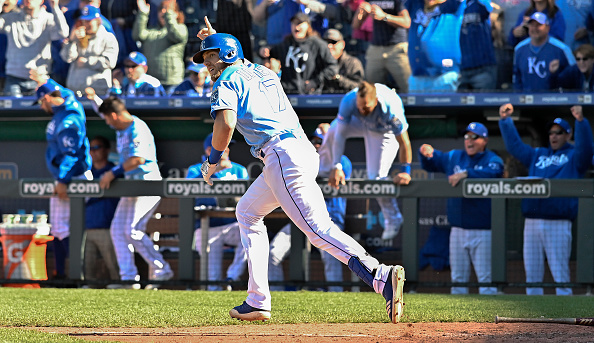In an effort to capture the essence of this series, this week, an under the radar player widely available could be percolating. Not only does Hunter Dozier own dual eligibility at first and third base, but he’s been making adjustments since arriving in the majors with the Royals. On the surface, his seven runs, three home runs and seven RBI with a .277/.352/.489 slash looks decent. Nothing to run to the wire for, unless ravaged by injuries.
However, Dozier’s about to face a steady diet of hitter friendly parks this week with trips to Chicago and New York. Entering game play on Monday, Dozier ranks 26th in expected slugging, according to Statcast, with a .619 mark, residing 130 points above his actual percentage. He’s also due for positive migration to the mean in weighted on-base average (wOBA) with an expected wOBA (xwOBA) of .414 compared to his .360 wOBA through his first 54 plate appearances.
It starts with his improved discipline metrics. Dozier’s swinging strike percentage of 13 percent does not seem egregious, but he’s cut it to 6.7 percent to this point. He’s also increased his contact percentage by eight points to 82.1 percent and his Z-Contact (Contact in the strike zone) sits at 95.7 percent. Here’s a look at his rolling game chart courtesy of Fangraphs:
Currently riding the crest of his weighted on-base average along with the elite contact in the strike zone, Dozier’s indeed percolating. But fantasy owners will need it to translate to the power department in order to invest. Again, in a small sample, Dozier’s increased his fly ball rate along with growing his home run per fly ball percentage to start 2019, without sacrificing hard hits. This could sustain Dozier’s power growth if it continues over a full season. It’s illustrated here:
Transitioning to Statcast, Dozier’s average exit velocity of his batted ball events (94.1 MPH) ranks in the top eighth of the league. It’s almost five MPH over his average from last year. He’s slightly increased his launch angle to 13.8 degrees, but, with a 96.3 average exit velocity on his fly balls and line drives along with 18 hard hit events (exit velocity of 95-plus MPH), Dozier’s improving across the board. Here’s his spray chart so far in his career:
In fact, bake in better luck against fastballs and Dozier could surge going forward. He’s only hitting .208 against fastballs so far but with a .336 expected average. Of more importance, his slugging against the pitch of .333 should improve when seeing his .704 expected slugging percentage. Dozier averages an exit velocity of 96 MPH versus them with a launch angle of 15 degrees.
When targeting players in the midst of a breakout, investing while they’re percolating compared to after they pop benefits fantasy owners. Dozier could turn in a strong week which would make him a popular target this weekend. Those in daily moves formats, can take a wait and see approach, but if Dozier starts hot this week, his price will rise with each home run. Plus, due to Kansas City’s propensity to be aggressive on the bases, Dozier could steal five-to-seven bases.
There’s no guarantee Hunter Dozier will indeed breakout. However, he’s turned in improved discipline metrics, hitting baseballs with increased exit velocity and stands to mine positive regression against fastballs. If all this happens, he could be on the precipice of a 25 home run season with a .270 or better average. Not all breakouts carry the same magnitude, but for Dozier, it could be worth the risk since the buy-in remains low to this point.

